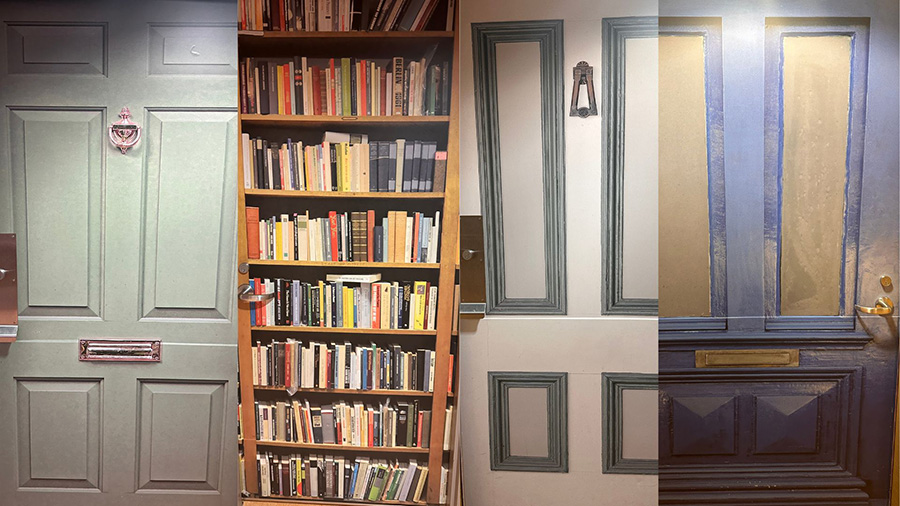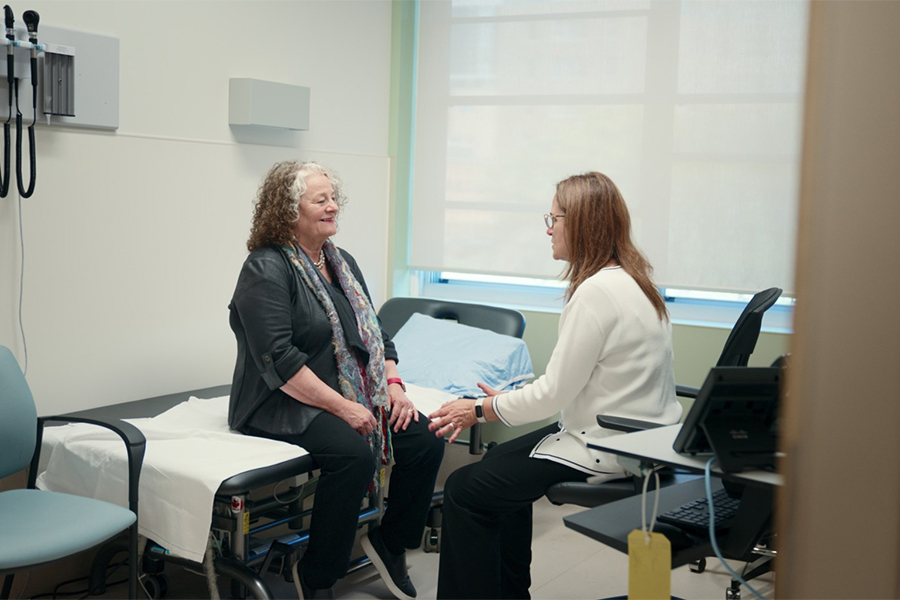Brenda Walton, (C, without mask), an inpatient at Toronto Rehab’s Specialized Dementia Unit, standing in front of two of the unit’s doors with members of the care team, (L to R), Twinkle Arora, a Clinical Research Associate, Amy Cockburn, Service Coordinator and Outreach Clinician, and Christine Dunning, an OTA/PTA. (Photo: UHN)
Toronto Rehab’s Specialized Dementia Unit (SDU) is home to a dynamic team of staff that is matched by an equally vibrant floor design.
Along the unit, each of the doors features different colours and patterns. More than just decoration, it’s a design introduced by the team as a way to help patients navigate the area with greater ease.
The 17-bed unit is where staff work to manage behaviours associated with dementia, which can interfere with a patient’s quality of life and a caregiver’s ability to provide the care someone needs to live well in the community.
A loss of direction is a common barrier for individuals with dementia. That can lead to distress and anxiety.
Distinctive designs make it easier for patients to remember, for example, that their room is the one with the green door.
Amy Cockburn, the Service Coordinator and Outreach Clinician, spearheaded the project after visiting long-term care centres and seeing the impact these designs have on residents.
Dr. Andrea Iaboni, a geriatric psychiatrist and scientist with UHN’s Kite Research Institute and Medical Lead of the Specialized Dementia Unit, says she agrees how beneficial environmental changes like this can be.
“It’s really important for patient experience,” says Dr. Iaboni. “Walking down a corridor of identical doors and not knowing which one is yours can be very disorienting and almost dystopian.
“All of these different doors make the unit feel like a neighborhood instead of a hospital.”
The door decals come from True Doors, a supplier in the Netherlands, which creates these designs with patients with dementia in mind. Each was installed strategically so no two side-by-side doors look alike.
Also, doors that staff do not want patients to enter, such as exits or certain offices, were disguised with decals like bookshelves.

This project not only benefits patients. Staff say they find the space more welcoming to work in and that it allows them to communicate with patients easier.
“When a patient needs help finding their room, we can give clear verbal directions like ‘it’s the green door on the left’ without having to accompany them,” Amy says.
Many of the staff members contributed to the installation, making it a special project for everyone.
“Tackling projects like this together really makes a difference for staff because they feel they’re part of something bigger,” says Amy.
“Day-to-day patient care is meaningful and working together as a team on a larger project that has long-term impact for the unit is very motivating.”
As the installation took place, new research technology, such as a location tracking system, was also installed to monitor patient activity.
Dr. Iaboni saw this as the perfect opportunity to combine these elements in a research project, evaluating the impact of the doors.
The research showed a decrease of 20 per cent to 30 per cent of patients walking into rooms other than their own.
“One of the goals of bringing this technology on the unit was to use it to evaluate design improvements,” says Dr. Iaboni.
“We are very interested in the idea of redesigning aspects of our unit to make them more dementia friendly.”
The team believes this is only the start to creating an enhanced environment for patients. Along with other design elements such as posters that look like a scenic window view, or ceiling tiles that look like a skylight, the doors are just part of what makes the Specialized Dementia Unit an exceptional area of Toronto Rehab.


